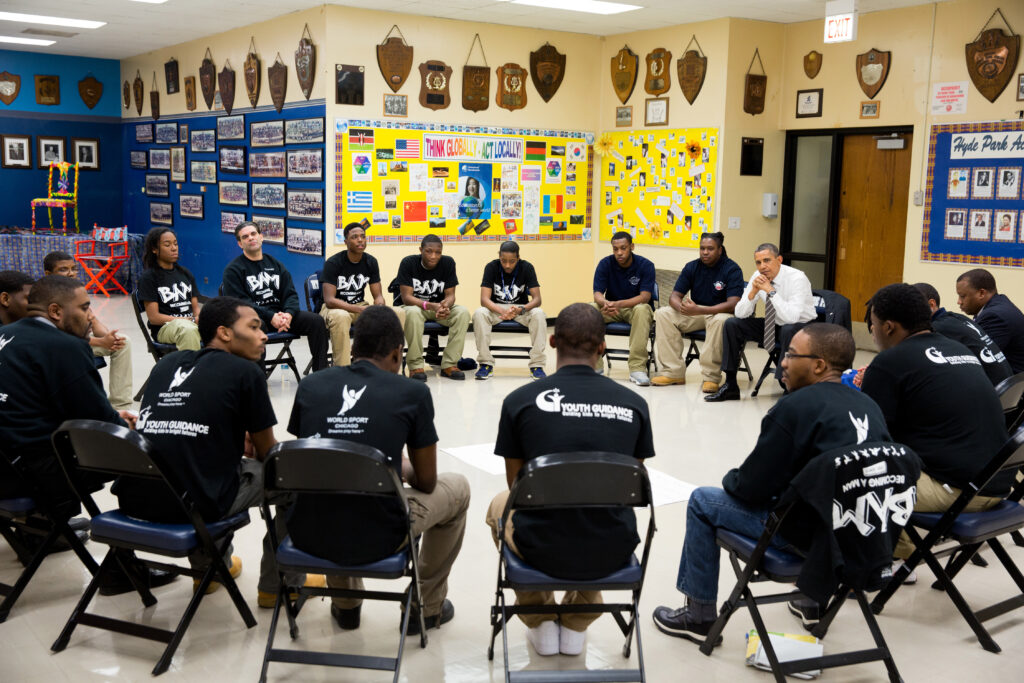Becoming a Man

Youth Guidance’s Becoming a Man (BAM) uses insights from behavioral science to help youth navigate high-stakes situations.
Challenge
Most homicides in the United States start with words. They are arguments that could have been de-escalated but weren’t, and they end in tragedy because someone has a gun.
Opportunity
Much of our behavior is driven by intuitive, almost automatic, decision-making, including our behavior in situations that could escalate into serious violence. BAM is a weekly in-school program that helps youth recognize their automatic responses and “slow down” their thinking in these high-stakes situations.
Project overview
Unlike what is commonly shown on movies or on television, gun violence in America is not primarily driven by drug wars between gangs, nor is it usually pre-planned or thought through. Instead, most homicides in the United States start with words. They are arguments that could have been de-escalated but weren’t, and they end in tragedy because someone has a gun.
Imagine you’re walking down the street and you see someone scowling in your direction. You might, even subconsciously, assume that the person is scowling not just near you but directly at you. (Behavioral scientists call this tendency “personalization.”) If you confront the scowler and they take it as a challenge, it’s easy for the situation to spiral out of control—and in a world where guns are readily available, this kind of everyday argument carries the risk of deadly consequences.
A growing body of research suggests that our behavior, including the behavior that leads to conflict, is driven by two very different types of decision-making, as illustrated by Daniel Kahneman in Thinking, Fast and Slow (2011): A lot of the behavior that each of us engages in every day is intuitive, even automatic, with little deliberate thought—using what behavioral scientists call your System 1. These automatic thoughts are susceptible to a number of learned mental shortcuts—like personalization—that can affect our judgments and decisions. Depending on the circumstances, decision-making and behavior can sometimes be more deliberate and reflective—using what psychologists call your System 2. But because deliberation is mentally costly, we usually rely on automatic responses.
Becoming a Man (BAM) is a behavioral science-informed program that helps reduce reliance on these automatic responses that we all experience but that have particularly high stakes in economically disadvantaged neighborhoods where guns are common. The program, developed by local nonprofit Youth Guidance, offers one hour, once-per-week group sessions held during the school day that help students notice their own thinking patterns and determine for themselves how best to respond to conflict. For example, to address personalization, BAM counselors have students ask themselves “What would a camera see?” encouraging them to reflect on the ways that the “objective” camera point of view might be different from their own subjective narrative about the situation. This exercise helps students consider alternative interpretations (for instance: a passing scowl from someone on the street might not be about you at all, but instead about a recent parking ticket).
The Crime Lab and Education Lab partnered with the City of Chicago, Chicago Public Schools, and Youth Guidance for over a decade to conduct four randomized controlled trials and a qualitative study to better understand the impact of the Becoming a Man program on students’ violence involvement and their schooling outcomes. The first study found that BAM reduced violent crime arrests by fully 45%. The program also had lasting impacts on school engagement: BAM increased on-time high school graduation rates by 19%. In the second study, BAM reduced violent crime arrests by 50%, and again had significant impacts on school engagement. Subsequent studies, which examined whether BAM would be effective across student groups and settings, revealed potential challenges in expanding BAM to serve different populations in different school and neighborhood contexts. A full technical report of all four studies can be found on the AmeriCorps website here and additional details can be found on the Results for America website here or on J-Pal’s website.
Our research led to a dramatic expansion of the BAM program and similar mentoring initiatives. Since the publication of the first study, BAM received over $100M in new public sector investment and started programming in schools in Boston, Dallas, Kansas City, Los Angeles, and London. Based on the strength of the BAM results, Mayor Rahm Emanuel’s Mayor’s Mentoring Initiative invested $36 million in mentoring programs in Chicago. BAM’s success also helped shape former President Obama’s My Brother’s Keeper initiative, which currently operates in 35 states. While these kinds of programs can be difficult to scale, as we’ve seen in some data for the earliest efforts to scale BAM, the research offers enormously promising evidence that this type of behavioral science-informed program can dramatically reduce gun violence.
Research Overview
The University of Chicago Crime Lab has evaluated BAM in four separate randomized controlled trials. The first two studies were conducted in the 2008-2009 school year in 18 Chicago Public Schools (CPS) and the 2013-2014 school year in 9 CPS schools. The results of these first two experiments are documented in the Quarterly Journal of Economics and can be found here.
In the second two studies, we aimed to evaluate whether BAM was effective across different student groups and different settings. These studies were conducted as part of a combined experiment in partnership with a high-impact tutoring program in the 2013-2014 school year (12 schools) and the 2014-2015 school year (21 schools). The results of these studies can be found here.
In each of these studies, the research team partnered with neighborhood high schools located in communities experiencing high rates of gun violence. Eligible high school boys in each of the neighborhood high schools were randomly assigned to either a group participating in BAM or a control group receiving status quo school and community services–which allowed the research team to understand the impact of the BAM program on student outcomes, as measured by administrative data collected by Chicago Public Schools and the Chicago Police Department.
In addition, we partnered with researchers from Chapin Hall to conduct a qualitative study to understand why we might see program effects and better understand the experiences of young people going through the program. The full qualitative report can be found here.
Study Results
In the first two studies, our research team found participation in BAM during the first study reduced violent crime arrests for youth in the program by 45%. The program also had lasting impacts on school engagement: BAM increased on-time high school graduation rates by 19%. In the 2013-2015 study, BAM reduced violent crime arrests by 50%, and again had significant impacts on school engagement. These large behavioral responses combined with modest program costs imply benefit-cost ratios for this intervention from 5-to-1 up to 30-to-1 from the reduction in crime alone. Potential increases in future earnings resulting from the impacts on high school graduation may mean the return on investment is far higher.
We also find evidence consistent with the idea that reduced automaticity helps explain program impacts. Our results suggest that it is possible to generate sizable changes in outcomes by helping youth recognize their own thinking patterns and make better decisions during high-stakes situations.
In our second two studies, we found the results of the intervention were more variable across student groups and settings; as a result, we were unable to detect a statistically significant effect of the program on student outcomes as the program expanded to serve different student populations in different school and neighborhood contexts.
These results do not affect our overall conclusions when we look at all four studies together, however. Our results that combine data from all four randomized controlled trials show that the program can reduce violent crime by up to 37% and improve school engagement by 0.03-0.08 standard deviations (which we estimate will translate to up to a 5 percentage point increase in high school graduation rates). We also find that the program has a benefit-cost ratio of between 2:1 and 10:1.
A full technical report of all four studies can be found on the AmeriCorps website here and additional details can be found on the Results for America website here or on J-Pal’s website.
Years Active
2009 – 2021
Topics
Project Leads
Sara Heller
Assistant Professor of Economics

Monica Bhatt
Senior Research Director

Anuj Shah
Associate Professor of Behavioral Science

Jens Ludwig
Pritzker Director

Sendhil Mullainathan
Roman Family University Professor of Computation and Behavioral Science at Chicago Booth

Harold Pollack
Co-Founder

Jon Guryan
Education Lab Faculty Co-Director


Scaling Promising Practices in Youth Mentoring
This case study by Results for America highlights the Crime Lab and Education Lab’s role in the City of Chicago’s bold initiative to expand the evidence-based Becoming a Man group mentoring model to serve thousands of young men.
Preventing Youth Violence: An Evaluation of Youth Guidance’s Becoming A Man Program
Read about a report prepared for the Edna McConnell Clark Foundation.
Bolstering Belonging in BAM and Beyond
Read more about the qualitative evaluation of Youth Guidance’s Becoming a Man program.

